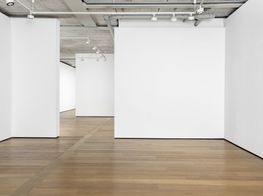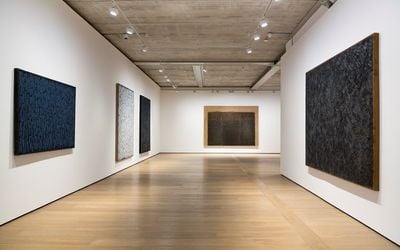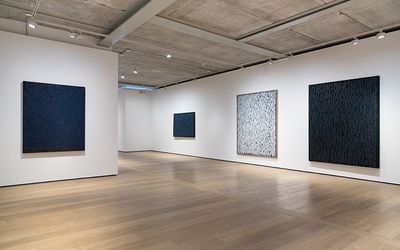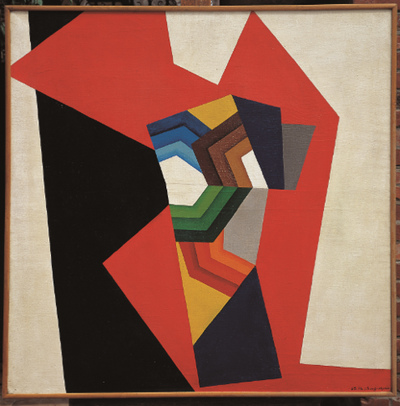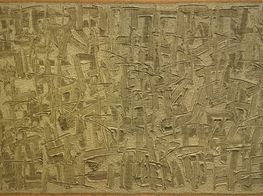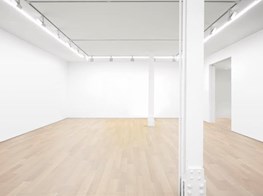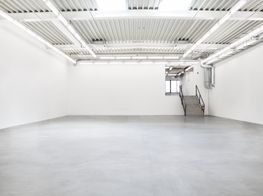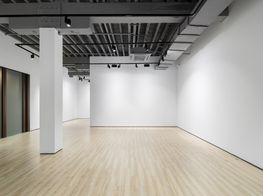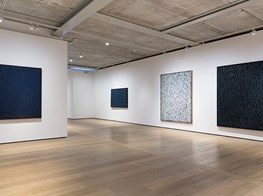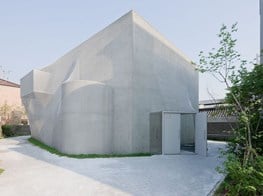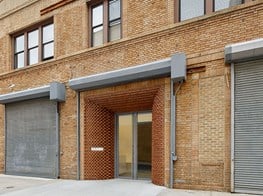Ha Chong-Hyun
Ha Chong-Hyun. Courtesy Almine Rech Gallery, Paris/London/Brussels/New York.
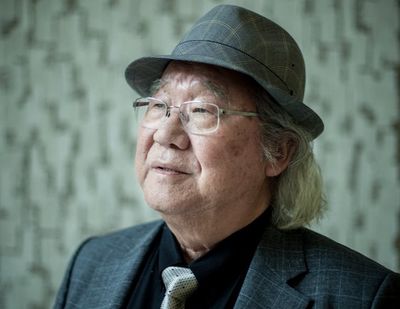
Ha Chong-Hyun. Courtesy Almine Rech Gallery, Paris/London/Brussels/New York.
Among the now internationally acclaimed Dansaekhwa artists, Ha Chong-Hyun (b. South Korea, 1935) is notable for his undeniable influence on the shifting landscape of Korean art in the 1960s and '70s. A part of the first wave of artists to embrace abstraction in South Korea, he also cofounded A.G., a pioneering avant-garde collective that gave rise to a new oppositional art. Ha's engagement with abstraction developed in tandem with Japanese Mono-ha, Arte Povera, and post-Minimalism, resulting in an aesthetic which focused on everyday objects, with an emphasis on their materiality. The artist rejected figuration and, strongly influenced by the social urgencies of a country entering a period of military dictatorship, responded to the unique political situation of South Korea with his material and colour selection.
Dansaekhwa, also known as the Korean monochromatic movement, is characterised by variable techniques and philosophies, but broadly defines a type of experimental painting that broke away from Korean art traditions while responding to European and American abstraction. Within the range of diverse approaches categorised as Dansaekhwa, Ha has created his own recognisable style. He is best known for his use of bae-ap-bub, which translates literally to 'back-pressure method' and involves placing colour on hemp-woven canvas from its verso. The irregular, loose structure of hemp allows him to press oil paints from the back before scraping broad sections to create swathes of movement on its surface. Ha's work speaks to the era in which he first began his practice. Graduating from Hongik University in Seoul in 1959, he incorporated the elements that were abundant in an economically and socially unstable conflict-torn country. Burlap sacks, of the kind used to transport goods by American soldiers during the Korean War, became a natural choice, in addition to barbed wire and metal coils.
Ha soon established a connection with the international art scene, participating in the 1961 Paris Biennale and the São Paulo Art Biennale in 1967. Gaining fame within Korea, he became dean of Hongik University's Fine Arts College (1990–1994) and later the director of the Seoul Museum of Art (2001–2006). But it wasn't until the recent meteoric rise of interest in Dansaekhwa that he gained notable global recognition. Art historian Joan Kee's 2013 publication Contemporary Korean Art: Tansaekhwa and the Urgency of Method, the first in-depth survey of the movement, is credited with sparking international interest. Less than a year later, Ha was included in major exhibitions on Dansaekhwa at Kukje Gallery in Seoul and Blum & Poe in Los Angeles (Kee curated the latter). His importance was further acknowledged in solo exhibitions at Tina Kim Gallery and Blum & Poe in New York, and he participated in a group show of Dansaekhwa artists at the Palazzo Contarini-Polignac during the 2015 Venice Biennale. Paris' Centre Pompidou, the Solomon R Guggenheim Museum and the Museum of Modern Art in (both in New York) have each organised exhibitions dedicated to Dansaekhwa.
Most recently, the artist, now 82 years old, is currently the subject of a new solo exhibition at Almine Rech Gallery in London, on view through 29 July 2017. The show features a selection of works from 'Conjunction' (1974–ongoing), a series that represents the evolution of the artist's sombre yet playful style. The paintings are an exploration of Ha's philosophy of material matter, and began as a way to transform physical labour into abstract composition. While his earlier work included installations made with newspapers, rope and other common objects, his training in painting led him to search for a method that could bridge sculptural forms with flat surfaces. Ha spoke with Ocula about the 'Conjunction' series, how his work responded to the modern history of Seoul and the continuing transformation of his technique.
IMYou're perhaps best known for your method of bae-ap-bub. How did you first come to this approach?
HCHBae-ap-bub is a method that is the opposite of traditional painting, or applying paint on the front surface of the canvas. I push paint from the back to the front of hemp cloth. I was interested in creating a whole new method of creating that involved both the back and front of the surface. Although it sounds simple, there are many variations when paint is pushed through the holes of a hemp cloth. Depending on the piece, some holes are big while some are small, and this affects the paint that seeps through. For instance, when the holes are small, meaning that the cloth is more tightly woven with thinner threads, the paint that comes out onto the surface is thinner and longer, creating a totally different effect from that applied to the more loosely woven cloth. On the other hand, the pressure that I apply gives countless variations to the paint that seeps through. It has always fascinated me to explore these different approaches and effects throughout my career, and I am still exploring this method.
IMYour choice of material (burlap, barbed wire, coil) very much reflected the political, social context in which you were working in the 1960s and '70s. As time passed, these materials naturally shifted and changed. How has your use of specific paints and canvases changed over the years, and why did you decide to continue with these materials?
HCHDuring the 1960s and '70s, I used materials that I was able to find easily around me. It was as simple as that. I could not afford other materials. However, at the same time, I was not interested in creating something that was already being done by other artists. I was always interested in exploring materials around me and creating something completely new. This is why there was a variety of materials in the works that I created during those times. I had to constantly change, because I could not afford to mass-produce a single type of work. It was also a time when I was young and wanted to explore everything. Not to mention, the socio-political situation was turbulent. I think this is reflected in my work. As time passed, modernisation rapidly took place, and South Korea became stable. We are now able to customise and do large-quantity productions. I now order my own hemp cloth and the colour of my own paints. Back in the early 1970s when I first began working on the 'Conjunction' series, I had to source hemp cloth individually for each work at the market or on the street, and I also had to mix the colours for each painting. As I mentioned, I keep on discovering new things with bae-ap-bub, but there has been some evolution of sourcing my materials. I wonder how it will evolve in the near future.
IMThe earliest works in the 'Conjunction' series were untitled except for a simple numeric convention that went by year and month of production. How did you come to add the word 'conjunction' to these works?
HCHIt took a great amount of effort to create the title of these works. I had to come up with a word that implied the feeling of when two things meet as equal entities and create something new harmoniously by being mixed. The title had to convey that there was a feeling of sticky fusion between the oil paint and the hemp cloth, but not too much. 'Combination' and 'bonding' did not really hold the same meaning that 'conjunction' seemed to have. I have continuously used the title 'conjunction' since the early 1970s, because it is really the essence of my work: the conjunction between the materials—oil paint and hemp cloth—and my spirit and performance.
IMYou challenge dimensionality and the essential properties of traditional painting. On a micro-scale, bae-ap-bub has a sculptural quality, yet the works as a whole reject this reading. How might one understand this tension at the core of 'Conjunction'?
HCHWhen I was working on sculpture and installation before the 'Conjunction' series, I remember that I always had an urge to go back to creating two-dimensional works, as I was trained in traditional painting. I made three-dimensional works not because it was my ultimate goal, but to return to two-dimension in a totally new way. I think this is why the 'Conjunction' series has that three-dimensional quality. My works finally found their way back to two-dimensionality, but with three-dimensional qualities.
IMSome of your earlier works, such as White Paper for Urban Planning (1967), demonstrated an understanding of spatial composition as influenced by the industrialising grid of Seoul. As the capital has changed drastically over the past several decades, how has your understanding of spatial relations shifted?
HCHAs you can see from the 'Urban Planning' series, straight lines and primary colours are prevalent. They were definitely influenced by the rapid growth of the economic landscape and the massive urban planning that took place. Construction was happening everywhere, and everyone was craving something new and modern. On the other hand, I was driven by this modernisation to find something old and traditional. I wanted to create modern works while incorporating something of my culture that has always been there. This is why my work, and the 'Conjunction' series, has organic colours but also dots and straight lines—marks that make strong reference to the 'Urban Planning' series I created in the past.
IMYour most recent works have incorporated smoke and soot, in addition to the typical oil paint. Why these elements and are you experimenting with any other new materials these days?
HCHRecently, I began to incorporate fire into the 'Conjunction' series. As I was constantly exploring materials with a limited palette, I always wanted to expand the use of colour but did not want to superficially create new shades to my original palette. I then thought about ways to naturally expand the colours and began to think about various natural elements in my surroundings. In addition, I have always been fascinated by Korean ceramics. Korean white porcelain is world-renowned and I love them very much. These ceramic wares are heated to high temperatures to be vitrified. The smoke that I use in my recent work is inspired from this process. By firing the works like baking pottery, I was able to develop more diverse colours without deliberately making new paints. I really liked how the smoke, a remnant from the natural element of fire, controlled and created a whole new layer of colours and gave new breadth to the paintings. I am still in the process of exploring the smoke and how it reacts to the materials, as well as how the paintings react to fire. I have not experimented with any new materials, but I certainly am more and more interested in looking at different colours.
IMUnexpected movements in the application of material in your paintings offer a sense of playfulness. This seems like a strategic incorporation of levity; could you speak to how play is important to your art?
HCHIt is interesting you say that my work has playfulness. In fact, my work is very serious. Nevertheless, I love people with humour and I tend to make humorous and odd comments in conversation. I like to laugh with people and make people laugh. This is my personality, and I think this personality has slipped through the work. The levity you mentioned is also interesting, and now that I look back, I do not like to have full control over the works. I like the surroundings of the work to have some interaction with it, and I am ready to let go of full control to the things that can happen—such as the degree of smoke on the painting and the path of oil that is created like the shadow of the paint between the painted surface and non-painted surface.—[O]

